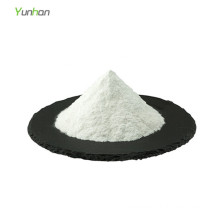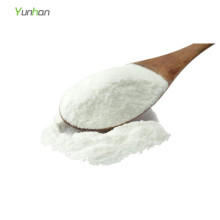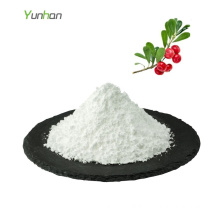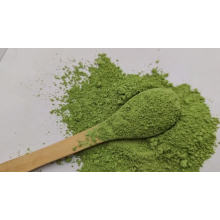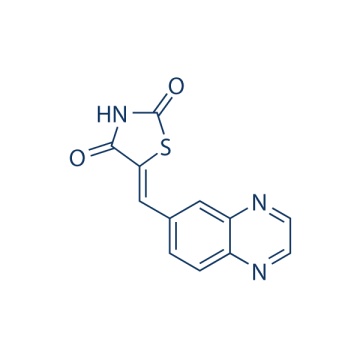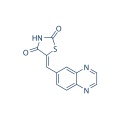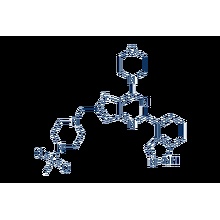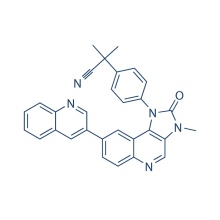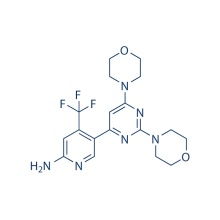AS-605240 648450-29-7
Product Description
.cp_wz table {border-top: 1px solid #ccc;border-left:1px solid #ccc; } .cp_wz table td{border-right: 1px solid #ccc; border-bottom: 1px solid #ccc; padding: 5px 0px 0px 5px;} .cp_wz table th {border-right: 1px solid #ccc;border-bottom: 1px solid #ccc; padding: 5px 0px 0px 5px;}
Molecular Weight: 257.27 AS-605240 selectively inhibits PI3Kγ with IC50 of 8 nM, over 30-fold and 7.5-fold more selective for PI3Kγ than PI3Kδ/β and PI3Kα, respectively.
AS-605240 is an ATP-competitive PI3Kγ inhibitor, with Ki values of 7.8
nM. AS-605240 is isoform-selective, for AS-605240 also inhibits PI3Kα,
β, and δ, with IC50 of 60, 270, and 300 nM, respectively. AS-605240
inhibits C5a-mediated PKB phosphorylation with IC50 of 90 nM. In bone
marrow-derived monocytes (BMDMs), AS-605240 (1 μM) blocks MCP-1- or
CSF-1-induced PKB phosphorylation. At SC-CA1 synapses in mice, AS-605240 (100 nM) eliminates NMDAR LTD, without affecting mGluR LTD, depotentiation, and LTP.
In RANTES-induced mouse model of peritonitis, AS-605240 reduces
neutrophil chemotaxis with ED50 of 9.1 mg/kg. In a αCII-induced
arthritis, AS-605240 (50 mg/kg) protects against αCII-IA symptom. In a
mouse model of collagen-induced arthritis, AS-605240 (50 mg/kg) also
suppresses joint inflammation and damage. In an
obesity-induced diabetes model (ob/ob mice), AS-605240 (10 mg/kg) lowers
blood glucose levels, significantly improves both insulin sensitivity
and glucose tolerance without affecting body weight. AS-605240 (30
mg/kg) displays more profound effects with slightly less weight gain.
Moreover, AS-605240 reduces the abundance of ATMs and the circulating
levels of MCP-1.
Cell Assay:
[1]
Animal Study:
[1]
Conversion of different model animals based on BSA (Value based on data from FDA Draft Guidelines)
For example, to modify the dose of resveratrol used for a mouse (22.4 mg/kg) to a dose based on the BSA for a rat, multiply 22.4 mg/kg by the Km factor for a mouse and then divide by the Km factor for a rat. This calculation results in a rat equivalent dose for resveratrol of 11.2 mg/kg.
Chemical Information
Molarity Calculator
Dilution Calculator
Molecular Weight Calculator
Contact us if you need more details on AS-605240 648450-29-7. We are ready to answer your questions on packaging, logistics, certification or any other aspects about 648450-29-7 AS-605240、648450-29-7. If these products fail to match your need, please contact us and we would like to provide relevant information.
Molecular Weight: 257.27 AS-605240 selectively inhibits PI3Kγ with IC50 of 8 nM, over 30-fold and 7.5-fold more selective for PI3Kγ than PI3Kδ/β and PI3Kα, respectively.
AS-605240 is an ATP-competitive PI3Kγ inhibitor, with Ki values of 7.8
nM. AS-605240 is isoform-selective, for AS-605240 also inhibits PI3Kα,
β, and δ, with IC50 of 60, 270, and 300 nM, respectively. AS-605240
inhibits C5a-mediated PKB phosphorylation with IC50 of 90 nM. In bone
marrow-derived monocytes (BMDMs), AS-605240 (1 μM) blocks MCP-1- or
CSF-1-induced PKB phosphorylation. At SC-CA1 synapses in mice, AS-605240 (100 nM) eliminates NMDAR LTD, without affecting mGluR LTD, depotentiation, and LTP.
In RANTES-induced mouse model of peritonitis, AS-605240 reduces
neutrophil chemotaxis with ED50 of 9.1 mg/kg. In a αCII-induced
arthritis, AS-605240 (50 mg/kg) protects against αCII-IA symptom. In a
mouse model of collagen-induced arthritis, AS-605240 (50 mg/kg) also
suppresses joint inflammation and damage. In an
obesity-induced diabetes model (ob/ob mice), AS-605240 (10 mg/kg) lowers
blood glucose levels, significantly improves both insulin sensitivity
and glucose tolerance without affecting body weight. AS-605240 (30
mg/kg) displays more profound effects with slightly less weight gain.
Moreover, AS-605240 reduces the abundance of ATMs and the circulating
levels of MCP-1.
| In vitro PI3K lipid kinase assay | (1) For PI3Kγ: human PI3Kγ (100 ng) is incubated at RT with kinase buffer (10 mM MgCl2, 1 mM β-glycerophosphate, 1 mM DTT, 0.1 mM Na3VO4, 0.1% Na Cholate and 15 μM ATP/100 nCi γ[33P]ATP, final concentrations) and lipid vesicles containing 18 μM PtdIns and 250 μM of PtdSer (final concentrations), in the presence of AS-605240 or DMSO. Kinase reaction is stopped by adding 250 μg of Neomycin-coated Scintillation Proximity Assay (SPA) beads. (2) For PI3Kα, β, and δ: varying amounts of ATP are incubated with the different purified PI3K isoforms and saturating concentrations of PtdIns. Consequently, IC50 determinations with PI3Kα, β, and δ, to evaluate inhibitor selectivity are performed as follows: 60 ng of PI3Kα are incubated at RT with kinase buffer, as described for PI3Kγ (but containing 89 μM ATP/300 nCi γ[33P]ATP and no Na Cholate, instead) and lipid vesicles containing 212 μM PtdIns and 58 μM of PtdSer. 100 ng of PI3Kβ are incubated at RT with kinase buffer (containing 70 μM ATP/300 nCi γ[33P]ATP, 4 mM MgCl2 and no Na Cholate) and lipid vesicles containing 225 μM PtdIns and 45 μM of PtdSer. 90 ng of PI3Kδ are incubated with kinase buffer (containing 65 μM ATP/300 nCi γ[33P]ATP, 1 mM MgCl2, and no Na Cholate) and lipid vesicles containing 100 μM PtdIns and 170 μM of PtdSer. The reactions are stopped after 2 hours. |
|---|
Cell Assay:
[1]
| Cell lines | RAW264 macrophages |
|---|---|
| Concentrations | 1 nM - 10 μM, dissolved in DMSO |
| Incubation Time | 30 min |
| Method | After a 3-hour starvation in serum-free medium, Cells are pretreated with AS-605240 or DMSO for 30 min and stimulated for 5 min with 50 nM of C5a. PKB phosphorylation is monitored using phosphorylated Ser473 Akt-specific antibody and standard ELISA protocols. |
Animal Study:
[1]
| Animal Models | RANTES-induced mouse model of peritonitis (female Balb/C or C3H), αCII-induced mouse model of arthritis, and collagen-induced mouse model of arthritis (CIA) (male DBA/1) | ||
|---|---|---|---|
| Formulation | Dissolved in 0.5% carboxymethylcellulose/0.25% Tween-20 | ||
| Dosages | 50 mg/kg | ||
| Administration | Orally | ||
| Solubility | 0.5% CMC/0.25% Tween 80, 11 mg/mL | ||
| * Please note that Selleck tests the solubility of all compounds in-house, and the actual solubility may differ slightly from published values. This is normal and is due to slight batch-to-batch variations. | |||
Conversion of different model animals based on BSA (Value based on data from FDA Draft Guidelines)
| Species | Baboon | Dog | Monkey | Rabbit | Guinea pig | Rat | Hamster | Mouse |
| Weight (kg) | 12 | 10 | 3 | 1.8 | 0.4 | 0.15 | 0.08 | 0.02 |
| Body Surface Area (m2) | 0.6 | 0.5 | 0.24 | 0.15 | 0.05 | 0.025 | 0.02 | 0.007 |
| Km factor | 20 | 20 | 12 | 12 | 8 | 6 | 5 | 3 |
| Animal A (mg/kg) = Animal B (mg/kg) multiplied by | Animal B Km |
| Animal A Km |
For example, to modify the dose of resveratrol used for a mouse (22.4 mg/kg) to a dose based on the BSA for a rat, multiply 22.4 mg/kg by the Km factor for a mouse and then divide by the Km factor for a rat. This calculation results in a rat equivalent dose for resveratrol of 11.2 mg/kg.
| Rat dose (mg/kg) = mouse dose (22.4 mg/kg) × | mouse Km(3) | = 11.2 mg/kg |
| rat Km(6) |
Chemical Information
| Molecular Weight (MW) | 257.27 |
|---|---|
| Formula | C12H7N3O2S |
| CAS No. | 648450-29-7 |
| Storage | 3 years -20℃Powder |
|---|---|
| 6 months-80℃in solvent (DMSO, water, etc.) | |
| Synonyms | |
| Solubility (25°C) * | In vitro | DMSO | 0.4 mg/mL (1.55 mM) |
|---|---|---|---|
| Water | <1 mg/mL ( | ||
| Ethanol | <1 mg/mL ( | ||
| In vivo | 0.5% CMC/0.25% Tween 80 | 11 mg/mL | |
| * <1 mg/ml means slightly soluble or insoluble. * Please note that Selleck tests the solubility of all compounds in-house, and the actual solubility may differ slightly from published values. This is normal and is due to slight batch-to-batch variations. | |||
| Chemical Name | (Z)-5-(quinoxalin-6-ylmethylene)thiazolidine-2,4-dione |
|---|
Molarity Calculator
Dilution Calculator
Molecular Weight Calculator
Contact us if you need more details on AS-605240 648450-29-7. We are ready to answer your questions on packaging, logistics, certification or any other aspects about 648450-29-7 AS-605240、648450-29-7. If these products fail to match your need, please contact us and we would like to provide relevant information.
Product Categories : PI3K/Akt/mTOR > PI3K Inhibitor
Other Products
Hot Products
Astragaloside AChlortetracycline HCl 64-72-2Paclitaxel 33069-62-4Dexamethasone Acetate 1177-87-3Dinaciclib (SCH727965) 779353-01-4CHIR-124 405168-58-3Ro3280 1062243-51-9TAME 901-47-3CCG-1423 285986-88-110058-F4 403811-55-2Dabigatran (BIBR 953) 211914-51-1H 89 2HCl 130964-39-5T0901317 293754-55-9Aprepitant 170729-80-3Turofexorate Isopropyl (XL335) 629664-81-9BMS-378806 357263-13-9

